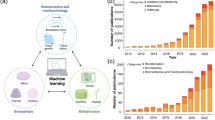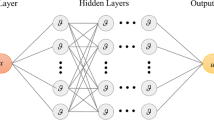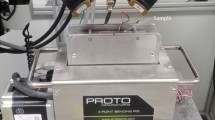Abstract
Constitutive modeling of the meniscus is critical in areas like knee surgery and tissue engineering. At low strain rates, the meniscus can be described using a hyperelastic model. Calibration of hyperelastic material models of the meniscus is challenging on many fronts due to material variability and friction. In this study, we present a framework to determine the hyperelastic material parameters of porcine meniscus (and similar soft tissues) using no-slip uniaxial compression experiments. Because of the nonhomogeneous deformation in the specimens, a finite element solution is required at each step of the iterative calibration process. We employ a Bayesian calibration approach to account for the inherent material variability and a Bayesian optimization approach to minimize the resulting cost function in the material parameter space. Cylindrical specimens of porcine meniscus from the anterior, middle and posterior regions are tested up to 30% compressive strain and the Yeoh form of hyperelastic strain energy density function is used to describe the material response. The results show that the Yeoh form is able to accurately describe the compressive response of porcine meniscus and that the Bayesian calibration and optimization approaches are able to calibrate the model in a computationally efficient manner while taking into account the inherent material variability. The results also show that the shear modulus or the initial stiffness is roughly uniform across the different areas of the meniscus, but there is significant spatial heterogeneity in the response at high strains. In particular, the middle region is considerably stiffer at high strains. This heterogeneity is important to consider in modeling the response of the meniscus for clinical applications.








Similar content being viewed by others
References
Abdelgaied A, Stanley M, Galfe M, Berry H, Ingham E, Fisher J (2015) Comparison of the biomechanical tensile and compressive properties of decellularised and natural porcine meniscus. J Biomech 48(8):1389. https://doi.org/10.1016/j.jbiomech.2015.02.044
Abraham AC, Edwards CR, Odegard GM, Donahue TLH (2011) Regional and fiber orientation dependent shear properties and anisotropy of bovine meniscus. J Mech Behav Biomed Mater 4(8):2024. https://doi.org/10.1016/j.jmbbm.2011.06.022
Armstrong C, Lai W, Mow V (1984) An analysis of the unconfined compression of articular cartilage. J Biomech Eng 106(2):165. https://doi.org/10.1115/1.3138475
Ballyns JJ, Bonassar LJ (2011) Dynamic compressive loading of image-guided tissue engineered meniscal constructs. J Biomech 44(3):509. https://doi.org/10.1016/j.jbiomech.2010.09.017
Bendjaballah M, Shirazi-Adl A, Zukor D (1995) Biomechanics of the human knee joint in compression: reconstruction, mesh generation and finite element analysis. Knee 2(2):69. https://doi.org/10.1016/0968-0160(95)00018-K
Betrò B (1991) Bayesian methods in global optimization. J Global Optim 1:1. https://doi.org/10.1007/BF00120661
Brochu E, Cora VM, de Freitas N (2010) A tutorial on bayesian optimization of expensive cost functions, with application to active user modeling and hierarchcal reinforcement learning. eprint arXiv:1012.2599, arXiv.org
Chia HN, Hull ML (2008) Compressive moduli of the human medial meniscus in the axial and radial directions at equilibrium and at a physiological strain rate. J Orthop Res 26(7):951. https://doi.org/10.1002/jor.20573
Chow MJ, Zhang Y (2011) Changes in the mechanical and biochemical propertihuang2011effectses of aortic tissue due to cold storage. J Surg Res 171(2):434. https://doi.org/10.1016/j.jss.2010.04.007
Coluccino L, Peres C, Gottardi R, Bianchini P, Diaspro A, Ceseracciu L (2017) Anisotropy in the viscoelastic response of knee meniscus cartilage. J Appl Biomater Funct Mater 15(1):77. https://doi.org/10.5301/jabfm.5000319
Cox DD, John S (1992) A statistical method for global optimization, [Proceedings] 1992 IEEE International Conference on Systems, Man, and Cybernetics. vol 2. pp 1241–1246. https://doi.org/10.1109/ICSMC.1992.271617
Criscione JC, Humphrey JD, Douglas AS, Hunter WC (2000) An invariant basis for natural strain which yields orthogonal stress response terms in isotropic hyperelasticity. J Mech Phys Solids 48(12):2445. https://doi.org/10.1016/S0022-5096(00)00023-5
Custódio AL, Madeira JA (2015) GLODS: global and local optimization using direct search. J Global Optim 62(1):1. https://doi.org/10.1007/s10898-014-0224-9
Danso E, Honkanen J, Saarakkala S, Korhonen R (2014) Comparison of nonlinear mechanical properties of bovine articular cartilage and meniscus. J Biomech 47(1):200. https://doi.org/10.1016/j.jbiomech.2013.09.015
De Rosa M, Filippone G, Best TM, Jackson AR, Travascio F (2022) Mechanical properties of meniscal circumferential fibers using an inverse finite element analysis approach. J Mech Behav Biomed Mater 126:105073. https://doi.org/10.1016/j.jmbbm.2022.105073
Doraiswamy S, Srinivasa AR (2013) A Bayesian approach to accounting for variability in mechanical properties in biomaterials. A bayesian approach to accounting for variability in mechanical properties in biomaterials. arXiv:org/abs/1312.2856
Dutton A, Choong P, Goh JC, Lee E, Hui J (2010) Enhancement of meniscal repair in the avascular zone using mesenchymal stem cells in a porcine model. J Bone Joint Surg. British volume 92(1), 169. https://doi.org/10.1302/0301-620X.92B1.22629
Fischenich KM, Boncella K, Lewis JT, Bailey TS, Haut Donahue TL (2017) Dynamic compression of human and ovine meniscal tissue compared with a potential thermoplastic elastomer hydrogel replacement. J Biomed Mater Res, Part A 105(10):2722. https://doi.org/10.1002/jbm.a.36129
Fithian DC, Kelly MA, Mow VC (1990) Material properties and structure-function relationships in the menisci. Clin Orthop Relat Res 252:19. https://doi.org/10.1097/00003086-199003000-00004
Fox AJ, Wanivenhaus F, Burge AJ, Warren RF, Rodeo SA (2015) The human meniscus: a review of anatomy, function, injury, and advances in treatment. Clin Anat 28(2):269. https://doi.org/10.1002/ca.22456
Freutel M, Seitz AM, Galbusera F, Bornstedt A, Rasche V, Knothe Tate ML, Ignatius A, Dürselen L (2014) Medial meniscal displacement and strain in three dimensions under compressive loads: MR assessment. J Magn Reson Imaging 40(5):1181. https://doi.org/10.1002/jmri.24461
Freutel M, Scholz N, Seitz A, Ignatius A, Dürselen L (2015) Mechanical properties and morphological analysis of the transitional zone between meniscal body and ligamentous meniscal attachments. J Biomech 48(8):1350. https://doi.org/10.1016/j.jbiomech.2015.03.003
Fu Y, Wang X, Yu T (2019) Simulation Analysis of Knee Ligaments in the Landing Phase of Freestyle Skiing Aerial. Appl Sci 9(18):3713. https://doi.org/10.3390/app9183713
Gabrion A, Aimedieu P, Laya Z, Havet E, Mertl P, Grebe R, Laude M (2005) Relationship between ultrastructure and biomechanical properties of the knee meniscus. Surg Radiol Anat 27(6):507. https://doi.org/10.1007/s00276-005-0031-6
García-Palomares UM, González-Castano FJ, Burguillo-Rial JC (2006) A combined global & local search (CGLS) approach to global optimization. J Global Optim 34(3):409. https://doi.org/10.1007/s10898-005-3249-2
Golowasch J, Goldman MS, Abbott L, Marder E (2002) Failure of averaging in the construction of a conductance-based neuron model. J Neurophysiol 87(2):1129. https://doi.org/10.1152/jn.00412.2001
Hallquist JO et al (2006) LS-DYNA theory manual. Livermore Softw Technol Corp 3:25
Henderson BS, Cudworth KF, Wale ME, Siegel DN, Lujan TJ (2022) Tensile fatigue strength and endurance limit of human meniscus. J Mech Behav Biomed Mater. https://doi.org/10.1016/j.jmbbm.2021.105057
Herwig J, Egner E, Buddecke E (1984) Chemical changes of human knee joint menisci in various stages of degeneration. Ann Rheum Dis 43(4):635. https://doi.org/10.1136/ard.43.4.635
Holzapfel G (2000) Nonlinear solid mechanics: a continuum approach for engineering. Wiley, New York
Howell R, Kumar NS, Patel N, Tom J (2014) Degenerative meniscus: pathogenesis, diagnosis, and treatment options. World J Orthoped 5(5):597. https://doi.org/10.5312/wjo.v5.i5.597
Imeni M, Seyfi B, Fatouraee N, Samani A (2020) Constitutive modeling of menisci tissue: a critical review of analytical and numerical approaches. Biomech Model Mechanobiol 19(6):1979. https://doi.org/10.1007/s10237-020-01352-1
Imler SM, Doshi AN, Levenston ME (2004) Combined effects of growth factors and static mechanical compression on meniscus explant biosynthesis. Osteoarthritis Cartilage 12(9):736. https://doi.org/10.1016/j.joca.2004.05.007
Jones DR, Schonlau M, Welch WJ (1998) Efficient global optimization of expensive black-box functions. J Global Optim 13:455. https://doi.org/10.1023/A:1008306431147
Kenja K, Madireddy S, Vemaganti K (2020) Calibration of hyperelastic constitutive models: the role of boundary conditions, search algorithms, and experimental variability. Biomech Model Mechanobiol 19(5):1935. https://doi.org/10.1007/s10237-020-01318-3
Koh YG, Park KM, Kang KT (2020) Finite element study on the preservation of normal knee kinematics with respect to the prosthetic design in patient-specific medial unicompartmental knee arthroplasty. BioMed Res Int. https://doi.org/10.1155/2020/1829385
Kolaczek S, Hewison C, Caterine S, Ragbar M, Getgood A, Gordon K (2016) Analysis of 3D strain in the human medial meniscus. J Mech Behav Biomed Mater 63:470. https://doi.org/10.1016/j.jmbbm.2016.06.001
Kulmala JP, Avela J, Pasanen K, Parkkari J (2013) Forefoot strikers exhibit lower running-induced knee loading than rearfoot strikers. Med Sci Sports Exerc 45(12):2306. https://doi.org/10.1249/MSS.0b013e31829efcf7
Lagarias J, Reeds J, Wright M, Wright P (1998) Convergence properties of the nelder-mead simplex method in low dimensions. SIAM J Optim 9(1):112. https://doi.org/10.1137/S1052623496303470
Lakes EH, Kline CL, McFetridge PS, Allen KD (2015) Comparing the mechanical properties of the porcine knee meniscus when hydrated in saline versus synovial fluid. J Biomech 48(16):4333. https://doi.org/10.1016/j.jbiomech.2015.10.046
Leslie B, Gardner D, McGeough J, Moran R (2000) Anisotropic response of the human knee joint meniscus to unconfined compression. Proc Inst Mech Eng [H] 214(6):631. https://doi.org/10.1243/0954411001535651
Lewis PB, Williams JM, Hallab N, Virdi A, Yanke A, Cole BJ (2008) Multiple freeze-thaw cycled meniscal allograft tissue: A biomechanical, biochemical, and histologic analysis. J Orthop Res 26(1):49. https://doi.org/10.1002/jor.20473
Long T, Lin CY, Vemaganti K (2020). Force-displacement respose of porcine meniscus in no-slip uniaxial compression. https://doi.org/10.7945/1k0e-ew43
Madireddy S, Sista B, Vemaganti K (2015) A Bayesian approach to selecting hyperelastic constitutive models of soft tissue. Comput Methods Appl Mech Eng 291:102. https://doi.org/10.1016/j.cma.2015.03.012
Madireddy S, Sista B, Vemaganti K (2016) Bayesian calibration of hyperelastic constitutive models of soft tissue. J Mech Behav Biomed Mater 59:108. https://doi.org/10.1016/j.jmbbm.2015.10.025
Manda K, Eriksson A (2014) Modeling of constrained articular cartilage growth in an intact knee with focal knee resurfacing metal implant. Biomech Model Mechanobiol 13(3):599. https://doi.org/10.1007/s10237-013-0521-0
Manual LDKU (2013) Vol. Livermore Software Technology Corporation (LSTC), I-II
Maritz J, Agustoni G, Dragnevski K, Bordas S, Barrera O (2021) The functionally grading elastic and viscoelastic properties of the body region of the knee meniscus. Ann Biomed Eng 49(9):2421
MATLAB (2019) MATLAB version 9.10.0.1613233 (R2021a). The Mathworks, Inc., Natick, Massachusetts
McDermott I, Amis A (2006) The consequences of meniscectomy. J Bone Joint Surg British Vol 88(12):1549. https://doi.org/10.1302/0301-620X.88B12.18140
Melly SK, Liu L, Liu Y, Leng J (2022) Modified Yeoh model with improved equibiaxial loading predictions. Acta Mechanica pp. 1–17. https://doi.org/10.1007/s00707-021-03105-2
Miles P, Hays M, Smith R, Oates W (2015) Bayesian uncertainty analysis of finite deformation viscoelasticity. Mech Mater 91:35. https://doi.org/10.1016/j.mechmat.2015.07.002
Mockus J (1994) Application of Bayesian approach to numerical methods of global and stochastic optimization. J Global Optim 4(4):347. https://doi.org/10.1007/BF01099263
Morejon A, Norberg CD, De Rosa M, Best TM, Jackson AR, Travascio F (2021) Compressive properties and hydraulic permeability of human meniscus: relationships with tissue structure and composition. Front Bioeng Biotechnol 8:1559. https://doi.org/10.3389/fbioe.2020.622552
Moroni L, Lambers FM, Wilson W, van Donkelaar C, de Wijn J, Huiskesb R, van Blitterswijk C (2007) Finite element analysis of meniscal anatomical 3D scaffolds: Implications for tissue engineering. Open Biomed Eng J 1:23. https://doi.org/10.2174/1874120700701010023
Mündermann A, Dyrby CO, D’Lima DD, Colwell CW Jr, Andriacchi TP (2008) In vivo knee loading characteristics during activities of daily living as measured by an instrumented total knee replacement. J Orthop Res 26(9):1167. https://doi.org/10.1002/jor.20655
Nelder J, Mead R (1965) A simplex method for function minimization. Comput J 7(4):308. https://doi.org/10.1093/comjnl/7.4.308
Norberg C, Filippone G, Andreopoulos F, Best TM, Baraga M, Jackson AR, Travascio F (2021) Viscoelastic and equilibrium shear properties of human meniscus: Relationships with tissue structure and composition. J Biomech 120:110343. https://doi.org/10.1016/j.jbiomech.2021.110343
Pena E, Calvo B, Martinez M, Palanca D, Doblaré M (2005) Finite element analysis of the effect of meniscal tears and meniscectomies on human knee biomechanics. Clin Biomech 20(5):498. https://doi.org/10.1016/j.clinbiomech.2005.01.009
Quiroga JP, Emans P, Wilson W, Ito K, van Donkelaar C (2014) Should a native depth-dependent distribution of human meniscus constitutive components be considered in FEA-models of the knee joint? J Mech Behav Biomed Mater 38:242. https://doi.org/10.1016/j.jmbbm.2014.03.005
Rasmussen CE, Williams CKI (2006) Gaussian processes for machine learning. MIT Press
Roan E, Vemaganti K (2007) The nonlinear material properties of liver tissue determined from no-slip uniaxial compression experiments. J Biomech Eng 129(3):450. https://doi.org/10.1115/1.2720928
Roan E, Vemaganti K (2011) Strain rate-dependent viscohyperelastic constitutive modeling of bovine liver tissue. Medical Biol Eng Comput 49(4):497. https://doi.org/10.1007/s11517-010-0702-2
Robertson D, Cook D (2014) Unrealistic statistics: how average constitutive coefficients can produce non-physical results. J Mech Behav Biomed Mater 40:234. https://doi.org/10.1016/j.jmbbm.2014.09.006
Robertson D, Cook D, Dhabi A (2015) In: Proceedings of the fifteenth international conference on civil, structural and environmental engineering computing, Prague, Czech Republic, pp 1–4
Russell C, Pedoia V, Souza R, Majumdar S (2017) Cross-sectional and longitudinal study of the impact of posterior meniscus horn lesions on adjacent cartilage composition, patient-reported outcomes and gait biomechanics in subjects without radiographic osteoarthritis. Osteoarthritis Cartilage 25(5):708. https://doi.org/10.1016/j.joca.2016.10.025
Sanchez-Adams J, Wilusz RE, Guilak F (2013) Atomic force microscopy reveals regional variations in the micromechanical properties of the pericellular and extracellular matrices of the meniscus. J Orthop Res 31(8):1218. https://doi.org/10.1002/jor.22362
Seitz AM, Galbusera F, Krais C, Ignatius A, Dürselen L (2013) Stress-relaxation response of human menisci under confined compression conditions. J Mech Behav Biomed Mater 26:68. https://doi.org/10.1016/j.jmbbm.2013.05.027
Seyfi B, Fatouraee N, Imeni M (2018) Mechanical modeling and characterization of meniscus tissue using flat punch indentation and inverse finite element method. J Mech Behav Biomed Mater 77:337. https://doi.org/10.1016/j.jmbbm.2017.09.023
Shahriari B, Swersky K, Wang Z, Adams RP, Freitas ND (2015) Taking the human out of the loop: a review of Bayesian optimization. Climate Change 2013 The Phys Sci Basis 104(1):1. https://doi.org/10.1109/JPROC.2015.2494218
Shawe-Taylor J, Cristianini N (2004) Kernel methods for pattern analysis. Cambridge University Press, Cambridge
Shemesh M, Shefy-Peleg A, Levy A, Shabshin N, Condello V, Arbel R, Gefen A (2020) Effects of a novel medial meniscus implant on the knee compartments: imaging and biomechanical aspects. Biomech Model Mechanobiol 19(6):2049. https://doi.org/10.1007/s10237-020-01323-6
Shende S, Gillman A, Yoo D, Buskohl P, Vemaganti K (2021) Bayesian topology optimization for efficient design of origami folding structures. Struct Multidiscip Optim 63(4):1907. https://doi.org/10.1007/s00158-020-02787-x
Shende S, Long T, Vemaganti K (2022) Bayesian optimization (BO) code for the Bayesian calibration of hyperelastic material models of porcine meniscus. https://doi.org/10.5281/zenodo.6588718
Shriram D, Yamako G, Kumar GP, Chosa E, Cui F, Subburaj K (2021) Non-anatomical placement adversely affects the functional performance of the meniscal implant: a finite element study. Biomech Model Mechanobiol 20(3):1167. https://doi.org/10.1007/s10237-021-01440-w
Sivia DS, Skilling J (2006) Data analysis - a Bayesian tutorial, 2nd edn. Oxford Science Publications, Oxford University Press, Oxford
Spilker RL, Suh JK, Mow VC (1990) Effects of friction on the unconfined compressive response of articular cartilage: a finite element analysis. J Biomech Eng. https://doi.org/10.1115/1.2891164
Sweigart M, Athanasiou K (2005) Biomechanical characteristics of the normal medial and lateral porcine knee menisci. Proc Inst Mech Eng [H] 219(1):53. https://doi.org/10.1243/095441105X9174
Sweigart M, Athanasiou K (2005) Tensile and compressive properties of the medial rabbit meniscus. Proc Inst Mech Eng [H] 219(5):337. https://doi.org/10.1243/095441105X34329
Sweigart M, Zhu C, Burt D, DeHoll P, Agrawal C, Clanton T, Athanasiou KA (2004) Intraspecies and interspecies comparison of the compressive properties of the medial meniscus. Ann Biomed Eng 32(11):1569. https://doi.org/10.1114/b:abme.0000049040.70767.5c
Takroni T, Laouar L, Adesida A, Elliott JA, Jomha NM (2016) Anatomical study: comparing the human, sheep and pig knee meniscus. J Exper Orthopaed 3(1):1. https://doi.org/10.1186/s40634-016-0071-3
Tanaka ML, Vest N, Ferguson CM, Gatenholm P (2014) Comparison of biomechanical properties of native menisci and bacterial cellulose implant. Int J Polym Mater Polym Biomater 63(17):891. https://doi.org/10.1080/00914037.2014.886226
Tas RP, Sampaio-Pinto V, Wennekes T, van Laake LW, Voets IK (2021) From the freezer to the clinic: Antifreeze proteins in the preservation of cells, tissues, and organs. EMBO reports 22(3), e52162. https://doi.org/10.15252/embr.202052162
Tissakht M, Ahmed A (1995) Tensile stress-strain characteristics of the human meniscal material. J Biomech 28(4):411. https://doi.org/10.1016/0021-9290(94)00081-E
Travascio F, Devaux F, Volz M, Jackson AR (2020) Molecular and macromolecular diffusion in human meniscus: relationships with tissue structure and composition. Osteoarthritis Cartilage 28(3):375. https://doi.org/10.1016/j.joca.2019.12.006
Tse CY, Nayeb-Hashemi H, Vaziri A, Canavan PK (2011) ASME international mechanical engineering congress and exposition, vol. 54884, pp 577–580. https://doi.org/10.1109/NEBC.2011.5778650
Van Rossom S, Smith CR, Thelen DG, Vanwanseele B, Van Assche D, Jonkers I (2018) Knee joint loading in healthy adults during functional exercises: implications for rehabilitation guidelines. J Orthopaedic Sports Phys Therapy 48(3):162. https://doi.org/10.2519/jospt.2018.7459
Warnecke D, Balko J, Haas J, Bieger R, Leucht F, Wolf N, Schild N, Stein S, Seitz A, Ignatius A et al (2020) Degeneration alters the biomechanical properties and structural composition of lateral human menisci. Osteoarthritis Cartilage 28(11):1482. https://doi.org/10.1016/j.joca.2020.07.004
Wheatley BB, Fischenich KM, Button KD, Haut RC, Donahue TLH (2015) An optimized transversely isotropic, hyper-poro-viscoelastic finite element model of the meniscus to evaluate mechanical degradation following traumatic loading. J Biomech 48(8):1454. https://doi.org/10.1016/j.jbiomech.2015.02.028
Wilson W, Van Rietbergen B, Van Donkelaar C, Huiskes R (2003) Pathways of load-induced cartilage damage causing cartilage degeneration in the knee after meniscectomy. J Biomech 36(6):845. https://doi.org/10.1016/S0021-9290(03)00004-6
Wu JZ, Dong RG, Schopper AW (2004) Analysis of effects of friction on the deformation behavior of soft tissues in unconfined compression tests. J Biomech 37(1):147. https://doi.org/10.1016/s0021-9290(03)00240-9
Wu X, Pei B, Wang W, Lu D, Guo L, He P (2021) Finite Element Analysis of a Novel Approach for Knee and Ankle Protection during Landing. Appl Sci 11(4):1912. https://doi.org/10.3390/app11041912
Yasura K, Mizuno Y, Nakagawa Y, Mori K, Takenaka M, Ohashi T, Yamada K, Kobayashi M, Ando K, Kuroki H et al (2007) Estimation of the mechanical property of meniscus using ultrasound: examinations of native meniscus and effects of enzymatic digestion. J Orthop Res 25(7):884. https://doi.org/10.1002/jor.20256
Yeoh OH (1993) Some forms of the strain energy function for rubber. Rubber Chem Technol 66(5):754. https://doi.org/10.5254/1.3538343
Zielinska B, Haut Donahue TL (2006) 3D finite element model of meniscectomy: changes in joint contact behavior. J Biomech Eng 10(1115/1):2132370
Author information
Authors and Affiliations
Corresponding author
Ethics declarations
Conflict of interest
The authors have no conflicts of interest to declare.
Additional information
Publisher's Note
Springer Nature remains neutral with regard to jurisdictional claims in published maps and institutional affiliations.
Rights and permissions
About this article
Cite this article
Long, T., Shende, S., Lin, CY. et al. Experiments and hyperelastic modeling of porcine meniscus show heterogeneity at high strains. Biomech Model Mechanobiol 21, 1641–1658 (2022). https://doi.org/10.1007/s10237-022-01611-3
Received:
Accepted:
Published:
Issue Date:
DOI: https://doi.org/10.1007/s10237-022-01611-3




